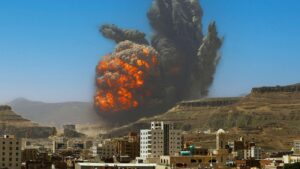By late February 1991, two of the most legendary battleships in history, USS Missouri and USS Wisconsin, lay just off the Kuwaiti coast. Silent but ready.
After years in mothballs, these ships had re-emerged at the president’s behest, this time as fully modernized war machines, with Tomahawk cruise missiles, advanced radar systems, and even drones now lining their decks.
The anxious Iraqi forces watched these World War 2 Veterans bring the beginning of an amphibious invasion right to their shores. With a single command, Missouri unleashed her firepower, reminding everyone that their most powerful asset needed no update. Her massive 16-inch guns, the same that had hammered enemy fortifications at Iwo Jima, roared to life. 2,700-pound shells tore through the air, crashing into Iraqi defenses along the coast. Moments later, Wisconsin joined the assault, her guns adding to the destruction.
For the Iraqis watching from the shore, the sheer force of the assault of the sister ships was overwhelming.
What they didn’t know was that these 887-foot-long behemoths were just one piece of a much larger, more complex strategy. As the thunderous guns of Missouri and Wisconsin held their attention, elsewhere, unseen and unexpected, the true nature of the coalition’s plan was about to unfold…
Video Transcript:
(00:01) By late February 1991, two of the most legendary battleships in history, USS Missouri and USS Wisconsin, lay just off the Kuwaiti coast. Silent but ready. After years in mothballs, these ships had re-emerged at the president’s behest, this time as fully modernized war machines, with Tomahawk cruise missiles, advanced radar systems, and even drones now lining their decks.
(00:31) The anxious Iraqi forces watched these World War 2 Veterans bring the beginning of an amphibious invasion right to their shores. With a single command, Missouri unleashed her firepower, reminding everyone that their most powerful asset needed no update. Her massive 16-inch guns, the same that had hammered enemy fortifications at Iwo Jima, roared to life.
(00:54) 2,700-pound shells tore through the air, crashing into Iraqi defenses along the coast. Moments later, Wisconsin joined the assault, her guns adding to the destruction. For the Iraqis watching from the shore, the sheer force of the assault of the sister ships was overwhelming. What they didn’t know was that these 887-foot-long behemoths were just one piece of a much larger, more complex strategy.
(01:23) As the thunderous guns of Missouri and Wisconsin held their attention, elsewhere, unseen and unexpected, the true nature of the coalition’s plan was about to unfold… By the late 1980s, despite the Cold War being in its final stages, global tensions remained high. As the United States cemented itself as the dominant global power, tensions simmered all the way in the Middle East, where Iraq’s longtime leader Saddam Hussein, facing crippling debt after years of war with Iran, decided on a bold solution.
(01:55) On August 2, 1990, Hussein’s forces invaded Kuwait, rapidly and crushingly overwhelming the small nation and seizing control of its vast oil reserves. The assault gave the dictator immense amounts of leverage over the global economy, setting off international outcry, with the United Nations imposing sanctions only days later.
(02:17) Nonetheless, Saddam still pressed forward. Now, with diplomacy about to exhaust, the world realized intervention was inevitable. Unwilling to let such a vital area of the world fall deep under hostile control, American President George H. W. Bush rallied an immense international effort.
(02:36) The leader assembled a 34-nation military coalition, one of the largest since World War 2, with well over 800,000 soldiers from countries like the United Kingdom, France, Saudi Arabia, and Egypt converging to work as one. That very same August, the United States launched Operation Desert Shield, a defensive mission with the ultimate purpose of protecting Saudi Arabia and its vital oil infrastructure from potential Iraqi aggression. With this, coalition forces fortified positions along the Saudi border.
(03:08) This operation bought the coalition critical time to organize its forces and prepare to go on the offensive for their next objective: liberating Kuwait. As Operation Desert Shield unfolded, the UN issued a blunt ultimatum to Saddam Hussein, resolution 678, authorizing the use of force if Iraq failed to withdraw from occupied Kuwait by January 15, 1991.
(03:34) With the clock now ticking, the coalition prepared for an all-out assault, a rare occurrence for the end of the 20th century. This would be no easy feat. Although Iraq’s armored forces were substantial, the multinational group held a clear numerical advantage. Yet, dislodging the invaders through sheer force would likely come with heavy losses.
(03:57) In response, General Norman Schwarzkopf, the commander of coalition forces, and his team of elite military strategists came up with a unique three-pronged strategy meant to outmaneuver Iraq’s defenses through a masterful blend of force and deception. The first prong involved a direct infantry assault, engaging Iraqi forces head-on to pin them down and prevent reinforcement of other positions.
(04:23) The second prong was a daring left hook flanking maneuver, where powerful tanks would sweep across the Kuwaiti and Iraqi deserts, bypassing enemy defenses and striking from the west, severing the invader’s supply lines and encircling their forces. But for the first two prongs to succeed, the third, and boldest of them all, had to be performed flawlessly. The plan called for a staged amphibious assault on Kuwait’s beaches.
(04:48) This elaborate ruse would make the enemy believe the main invasion would surge from the Persian Gulf. Assuming the attack would develop in the water, top brass would send all the Iraqi defenses and all their men and materiel there, allowing the real assaults from the first two prongs to thunder seamlessly from inland, striking hard from the south and west, slicing through supply lines, ensnaring Iraqi forces, and driving relentlessly toward the capital.
(05:14) In order to sell this important element of their plan, the coalition needed overwhelming naval firepower. And nothing was more convincing than the presence of massive battleships. As fate would have it, the United States Navy had just the right ships for the operation. USS Wisconsin, an Iowa-class battleship, was commissioned in April 1944 and entered the Pacific theater that fall.
(05:45) For nearly a year, she and her men played a key role in delivering crucial fire support during bombardments of Japanese-held islands, escorting carrier strike groups as they launched air attacks. This was mainly achieved through her primary weapon system: nine massive 16-inch guns housed in three massive turrets capable of hurling 2,700-pound shells up to 23 miles.
(06:06) The ships also carried an array of 5-inch dual-purpose guns for anti-aircraft and surface-to-surface weapons. Meanwhile, her sister ship, USS Missouri, was commissioned a little bit later, in June 1944, and joined the war too late to make much of a difference in the already winning tides of the end-stage Pacific Theater.
(06:29) Beginning in January 1945, “Mighty Mo” rained artillery support during the invasions of Iwo Jima and Okinawa. Most importantly, she was the center of one of the most significant moments of the entire war, when on September 2, 1945, her deck was the site of the formal surrender of Japan in Tokyo Bay, marking the end of World War 2, and, to many, the end of the battleship’s golden era.
(06:51) When the Korean War began in 1950, both sisters answered the call once more, hammering North Korean defenses and troop concentrations, targeting supply lines and key infrastructure. With a top speed of 33 knots, these Iowa-class ships could outpace many contemporaries, seamlessly keeping up with fast-moving carrier groups and responding to shifting battle conditions.
(07:14) Yet, despite the Iowa-class ship’s continued effectiveness and track record, new technology, spurred by the beginning of the Cold War, rapidly outmatched these once-dominant battleships, causing them both to be decommissioned and placed into the Mothball Fleet in 1955, where they would lie dormant for decades.
(07:34) By the mid-1980s, naval warfare had evolved significantly. Nonetheless, President Ronald Reagan, looking to bolster America’s naval power with a blend of traditional strength and cutting-edge technology, launched the ambitious 600-ship Navy plan, a massive initiative to expand the U.S. fleet and reaffirm its maritime dominance.
(07:54) The leader recognized that in a world where Cold War boiling points could tip over at any moment, the massive firepower and imposing presence of the battleships still held a powerful strategic and also symbolic value of American power. With this, all four of the available Iowa-class battleships were reactivated.
(08:13) However, to accurately face modern threats, they needed major upgrades. While the battleships retained their iconic guns, their firepower was vastly expanded with the integration of 32 Tomahawk cruise missiles, long-range, precision-guided weapons that could strike targets deep inland. A set of Harpoon anti-ship missiles also bolstered her offensive might.
(08:36) In order to counter modern threats like incoming missiles and aircraft, shipyard workers installed the Phalanx Close-In Weapon System, CIWS, featuring radar-guided guns. Other critical upgrades included improvements to radar, fire-control systems, and electronic warfare capabilities.
(08:57) Now, with their modernization ready, the two sister ships were ready to fight side by side once more. Section Break As the January 15 deadline approached, the two colossal, 887-foot American battleships—USS Wisconsin and USS Missouri—appeared menacingly off the Kuwaiti coast. The former had arrived in late August, followed by the latter in November.
(09:22) As Saddam Hussein braced for full-blown war with the coalition, his large forces appeared powerful, both on paper and publicly. But despite being equipped with Soviet and Western-made tanks, aircraft, and missiles, his men were tired and most definitely battle-hardened by a decade of brutal conflict with Iran.
(09:41) On January 15, 1991, President Bush addressed the nation and the entire world by stating: [QUOTE] “Saddam has arrogantly rejected all warnings. Instead, he tried to make this a dispute between Iraq and the United States of America. Well, he failed. Tonight, 28 nations—countries from 5 continents, Europe and Asia, Africa, and the Arab League—have forces in the Gulf area standing shoulder to shoulder against Saddam Hussein.
(10:12) “ It was finally official: a new era of war had begun. The coalition had the most advanced military technology of the time—precision missiles, stealth bombers, and high-tech airpower—dominating the battlefield and terrorizing the enemy. Yet, even amidst this cutting-edge warfare, a duo of battleship legends of a bygone era were vital to the success of Operation Desert Storm.
(10:36) The sister ships’ last battle had been in Korea, and now, 40 years later, they were thundering into action as if time had never passed. At exactly 1:40am on January 17, 1991, USS Missouri launched her first Tomahawk missile, sending it streaking into the midnight sky and marking her triumphant return to battle.
(10:58) Moments later, her iconic 16-inch guns opened fire, her first combat bombardment since March 1953; the thunderous roar of her cannons echoed loudly across the desert as they targeted an Iraqi command and control bunker near the Saudi border. While Missouri delivered her blows, USS Wisconsin took on an equally critical role.
(11:20) As the official Tomahawk Land Attack Missile, TLAM, strike commander for the Persian Gulf, she coordinated the opening missile salvo of the campaign. In those first crucial days, Wisconsin fired a total of 24 Tomahawk missiles, each one aimed at vital targets deep inside Iraq. With this, the ruse was now in motion.
(11:43) On January 29, 1991, the frigate USS Curts led USS Missouri northward, her advanced mine-avoidance sonar guiding the massive battleship through treacherous waters. Just days later, on February 3, Missouri unleashed another barrage, this time bombarding Iraqi beach defenses, firing a total of 112 rounds.
(12:05) These operations were coordinated by a Marine OV-10 Bronco; the aging model, much like the battleships, defied expectations and proved their worth despite having been considered relics of an earlier time. In the weeks leading up to the late February invasion, United States top commanders knew how to seize the world’s attention to continue with the ruse.
(12:29) The comeback of the sister ships—USS Missouri and USS Wisconsin—with their massive 16-inch guns became the focal point of global speculation. Front pages around the world buzzed with reports hinting at an impending amphibious assault. Even The New York Times fell under the spell, with one report from February 4 capturing the growing anticipation: [QUOTE] “Powerful guns aboard the battleship Missouri lobbed 2,700-pound shells against Iraqi command bunkers near the Kuwaiti coastline, military command officials said, describing the shore bombardment as a further indication that an American-led
(13:02) amphibious assault on occupied Kuwait might be drawing near.” The world was watching, and even the general public had to believe the fake invasion. Two days later, on February 6, USS Missouri was relieved in the gunfire support role by her sister ship, USS Wisconsin.
(13:29) That same day, escorted by USS Nicholas, she unleashed her fury, sending 11 shells across 19 miles, obliterating an Iraqi artillery battery in southern Kuwait. The following day, she finally got an opportunity to use one of her greatest technological updates, bringing into the fight the ship’s own RQ-2 Pioneer Unmanned Aerial Vehicle, marking the first time a drone had been used in combat to spot targets.
(13:52) Guided by this unmanned eye in the sky, Wisconsin seamlessly hammered a communications compound, raining down 24 shells on Iraqi missile facilities, artillery sites, and electronic warfare positions along the coastline. That same evening, she fired 50 additional rounds in nearby piers, sinking or heavily damaging more than a dozen ships.
(14:13) On February 9, Wisconsin continued her assault, pounding bunkers and fortified positions while targeting enemy troops near Khafji, lending support to Saudi and Qatari forces that were pushing the enemy forces out of the city. In the days that followed, her sister ship, Missouri, resumed bombardment in the area, unleashing 60 more rounds before they headed to Faylaka Island for her next mission the following week.
(14:38) On the way there, the UAVs continued to prove their worth, this time spotting a convoy of trucks resupplying an Iraqi command post; Wisconsin wasted no time leveling ten buildings and delivering a powerful blow. For days, the two sisters continued to work in tandem, alternating along the coastline, dismantling Iraqi defenses and forcing them to stay pinned to the coast, their combined firepower paving the way for the coalition’s next move.
(15:08) On the night of February 23, both battleships turned their guns on Faylaka Island, with the goal of using their guns to create a diversionary strike to convince Iraqi forces that the amphibious invasion was now imminent. Missouri opened the assault, tearing into Iraqi defenses, lighting up the night with each impact of her Mark 8 armor-piercing shells, each weighing a massive 2,700 pounds, aided by her Pioneer drone, which continued to scout targets for the ship.
(15:36) Below, explosions rocked the coastline, with shells raining down on entrenched Iraqi positions, shaking the dug-in troops and filling the air with chaos and fear. After Missouri finished its devastating assault, Wisconsin followed suit, launching her Pioneer drone to scan for more targets.
(15:55) This time, however, as the drone’s low and menacing buzz reverberated over the island, the Iraqis had had enough. Having just witnessed Missouri’s brutal barrage, the terrified men began waving makeshift white flags, signaling their desperate attempt to surrender—not to soldiers, but to a machine in the sky.
(16:12) Amused, Wisconsin’s drone operators radioed their commanding officer, Captain David Bill III, asking: [QUOTE] “Sir, they want to surrender. What should I do with them?” This unbelievable moment became the most defining and remembered moment of the entire Gulf War and also marked the first time in history an enemy surrendered to an unmanned drone controlled by a ship.
(16:35) The following day, Wisconsin and her crew responded to multiple calls for fire support, blasting entrenched Iraqi troops from their bunkers. After witnessing the destruction unleashed by the sister ships, a Saudi marine commander couldn’t help but remark over the radio: [QUOTE] “I wish we had a battleship in our navy! Yet, as Missouri and Wisconsin continued to hold the line without fault, the Iraqis had one more desperate and dangerous move to play.
(17:04) The next day, USS Missouri edged within ten miles of the Kuwaiti coast, escorted by USS Jarrett and HMS Gloucester for security. The illusion was still holding, and just before 1:00am, Mighty Mo’ shot once again at Iraqi positions, pounding all along the coastline.
(17:25) To make the deception even more convincing, ten Marine Corps helicopters launched a feint near Ash Shuaybah, their engines roaring across the Gulf. This brazen move would not go unnoticed by the enemy, and this time, Iraq would not sit back. At 4:52am, just as the helicopters pulled away, Iraqi forces—still convinced the invasion was coming from the sea—responded by launching a duo of Silkworm missiles from the shore, aimed directly at Missouri.
(17:55) An A-6 Intruder circling above immediately picked up the launch and reported two distinct trails streaking through the sky. The first missile, confused by the chaff fired from the flotilla, veered off and crashed harmlessly into the sea between Missouri and Jarrett. But the second missile wasn’t slowing down. Instead, it sped toward Missouri, locked on and closing the distance fast.
(18:16) Detected more than 20 miles out, it was tracking straight for the battleship. In video footage from that day, a chilling call across the ship’s comms: [QUOTE] “Missile inbound… brace for shock.” With this, all the men aboard Mighty Mo’ were beginning to fear for their lives. Nearby, HMS Gloucester, one of the ships providing a defense, picked up the incoming missile on the radar. Reacting instantly, the destroyer launched two Sea Dart missiles.
(18:49) Once in the sky, they connected with their target, obliterating the Silkworm before it could reach Missouri. This event marked the first successful missile versus missile engagement at sea in combat. Now, with the biggest threat out of the way, an E-2C Hawkeye, circling high above, quickly coordinated with surveillance assets to pinpoint the launch site.
(19:10) With the location locked in, Intruder attack aircraft were dispatched to deliver their payload. No less than a dozen Mk20 Rockeye cluster bombs rained down on the missile site, wiping out the remaining missile batteries and reducing them to rubble. While the Silkworm threat was no more, only a few hours later, another close call occurred.
(19:32) It was still February 25, and USS Missouri continued pounding Iraqi targets along the coast, her guns thunderously echoing across the water. The battle seemed endless, but while HMS Gloucester had moved on, Missouri was now accompanied by USS Jarrett, HMS Atherstone, and HMS Exeter. Amid the bombardment, the situation took another dangerous turn when HMS Exeter spotted thick black smoke rising from an oil well that Iraqi forces had set ablaze.
(20:01) The tension on board Missouri escalated as the alert went out—a missile launch seemed imminent. It was only hours since Missouri had narrowly escaped the first missile strike, and now the crew was ordered to brace for impact once again. In an instant, Missouri deployed her chaff countermeasures, hoping to confuse the incoming missile’s guidance systems.
(20:23) But what followed was something no one saw coming. The chaff drifted between Missouri and Jarrett, and suddenly, Jarrett’s Phalanx defense system, set to auto-engage, identified the chaff as a threat. Without warning, the 20-millimeter cannons from Jarrett opened fire, locking onto the chaff cloud—and hitting Missouri.
(20:42) The burst of rounds sprayed across the battleship, jolting the crew as friendly fire struck home. In the confusion of this technological blunder, word aboard Mighty Mo spread that a gas attack could be imminent. Sailors scrambled to put on their gas masks, the fear of chemical warfare hanging over every second, adding to the chaos.
(21:03) Yet again, Missouri had narrowly escaped disaster. The damage was superficial, and no one aboard was seriously hurt, but it was a close call—one too many in a single day. After what felt like hours, the tension broke, and the crew, still braced for impact, was finally ordered to stand down.
(21:26) Though they were still instructed to wear protective gear, the all-clear came at last. Over the intercom, the Executive Officer’s voice broke the silence: (QUOTE) “All stations, relax the gas masks. […] there’s no reported gas and no missile activity.” Relief washed over the ship. The looming threat of chemical weapons had hovered over every moment of the Gulf War, keeping the crew on edge. But, for now, the danger had passed.
(21:49) Bill Genereux, a crew member working on the systems that aimed Missouri’s guns, later described the tension of that day while stationed in the battery plotting room: (QUOTE) “This memory is forever embedded in my memory […] I was deep inside of an armored World War 2 battleship. The plotting room is one of a battleship’s ‘vital organs’ so to speak.
(22:10) It is the brains to the ship’s brawn, the 16″ guns. Without the computer equipment in this space, the ship cannot fight, so it is located deep inside the armored belt, right next to the engine spaces, meant to be safe from… shells and torpedoes. Even so, with a missile bearing down on you and you can do nothing but stand there and take whatever is coming, you have to wonder if this could be the end?” As coalition forces continued with the actual ground offensive on February 25, naval forces along the coast prevented any sort of redeployment.
(22:45) On February 26, in the heart of the desert, Captain H.R. McMaster led his troop into the Battle of 73 Easting. In a stunning display of precision and speed, a single unit of Abrams tanks and Bradley fighting vehicles decimated 44 Iraqi tanks and armored vehicles without suffering a single loss.
(23:05) This decisive inland victory became an iconic moment in what would be known as the 100-hour war. That same day, Missouri began armistice enforcement operations. Finally, on February 28, after weeks of relentless coalition advances, Saddam Hussein, facing overwhelming losses and the absolute collapse of his military, accepted the coalition’s terms for peace, and President Bush officially called for an end to the hostilities.
(23:33) By then, these sister ships had collectively unleashed more than one million pounds of explosives against Iraqi positions. That same day, Wisconsin fired the last naval gunfire-support mission of the war, becoming the final battleship in world history to see action. While the coalition suffered the loss of 300 troops, this number was far lower than expected, largely thanks to the successful ruse that kept Iraqi forces pinned to the coast, unable to focus on the true threat deeper inland. On the other side, Iraqi forces paid a heavy price,
(24:05) with an estimated 10,000 fallen troops and their armored divisions left in ruins. Over eight months in service in the Persian Gulf, USS Wisconsin logged 348 UAV hours, completed 661 safe helicopter landings, traveled 46,000 nautical miles, and unleashed 319 16-inch shells, 881 5-inch shells, and 5,200 rounds from its Phalanx CIWS. She also launched 24 Tomahawk cruise missiles.
(24:38) For her part, USS Missouri cleared 15 naval mines, fired 759 16-inch shells, and launched 28 Tomahawk cruise missiles. Though the battleships had proven their worth in Desert Storm, as the Soviet threat collapsed that same year, all remaining battleships were taken out of service. In the end, these sister battleships, veterans of three wars spanning nearly five decades, received numerous awards for their service. Today, they are preserved as museum ships.
























